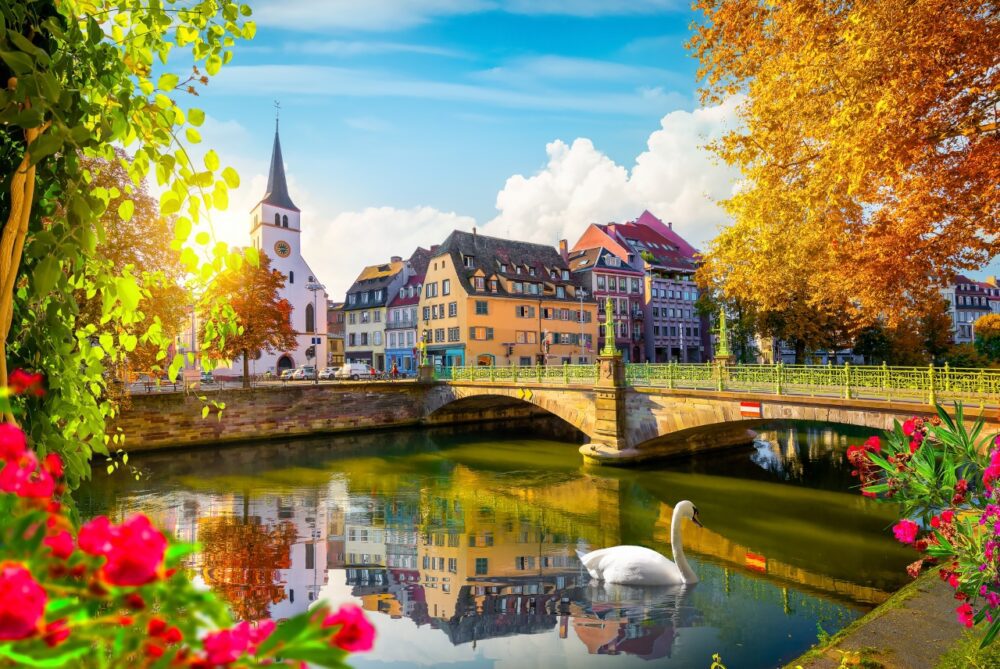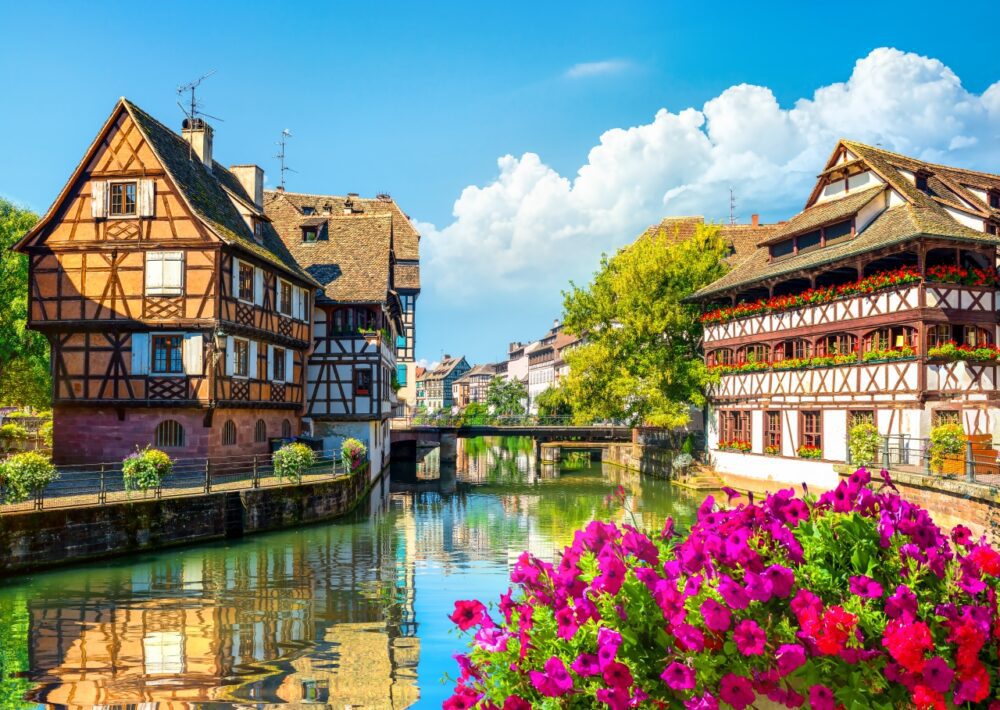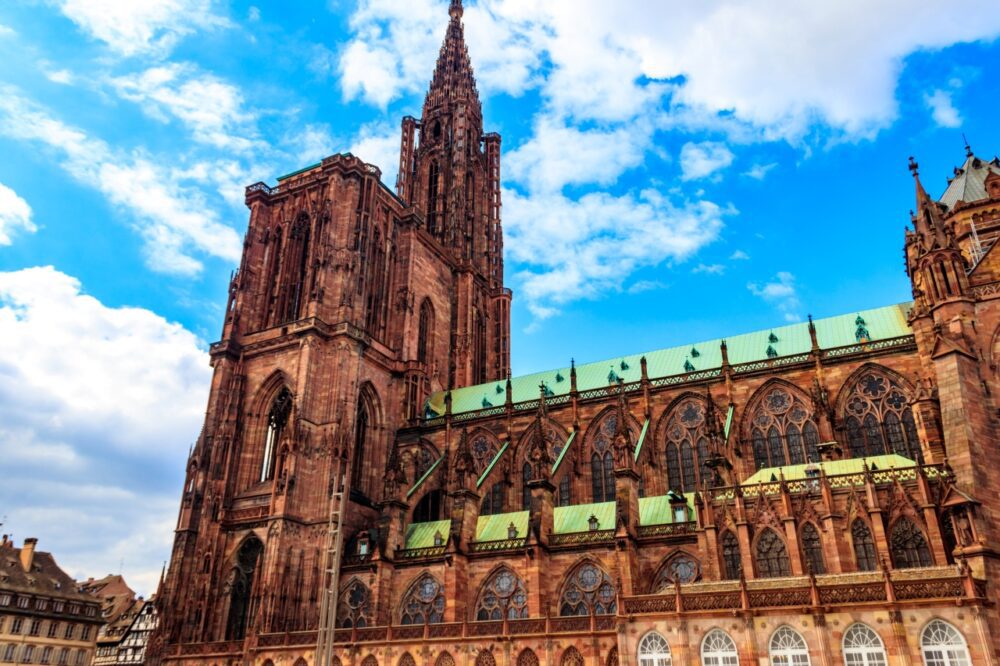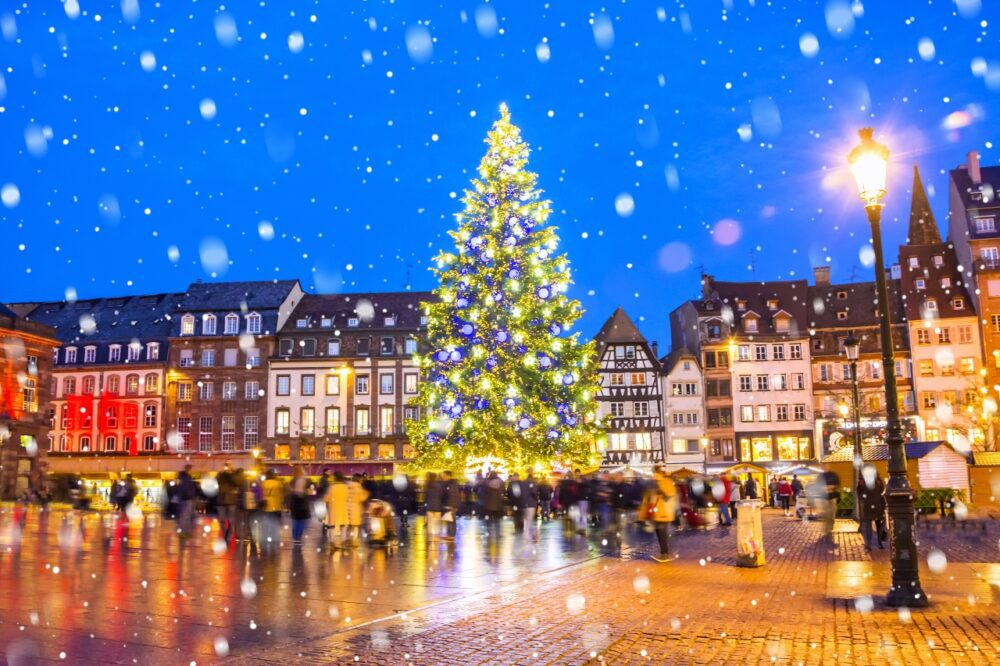
Is Strasbourg worth visiting? Without a doubt! The first time I set foot in Strasbourg, I felt like I’d stumbled into a storybook. With its half-timbered houses, winding canals, and the majestic Strasbourg Cathedral, the city has an undeniable charm. As I wandered through the cobbled streets of Petite France and indulged in a tarte flambée at a riverside café, I realised Strasbourg was a perfect blend of French elegance and Germanic tradition.
Nestled in the Alsace region of France, Strasbourg is a city where cultures collide. Known as the seat of the European Parliament, it’s a place of political importance and historical significance. Strasbourg boasts a stunning Old Town, designated a UNESCO World Heritage Site, alongside a vibrant culinary scene that highlights the best of French and German flavours. Whether you’re taking a boat ride through the canals, admiring the intricate details of the cathedral, or exploring the Christmas markets in winter, Strasbourg offers a rich and immersive experience. But is Strasbourg worth visiting for you?
In this blog post, we’ll uncover the top 10 reasons why Strasbourg should be on your travel list, from its unique architecture to its unforgettable cuisine. Plus, we’ll share travel tips to help you plan the perfect visit. Keep reading to discover why Strasbourg might just become your favourite French city.
Table of Contents
Pros – Reasons You Should Visit Strasbourg
1. A Stunning Blend of French and German Architecture

Strasbourg’s unique location near the German border has given it a fascinating mix of French and German influences, which is most evident in its architecture. The city’s half-timbered houses, medieval bridges, and grand European-style squares make it one of the most picturesque places in France.
Walking through the historic district of La Petite France felt like stepping into a fairy tale. The canals reflected rows of charming houses with wooden beams and flower-filled balconies, while cobbled streets led to hidden courtyards and cozy cafés. The blend of Alsatian, French, and German architectural styles gives Strasbourg an atmosphere unlike any other city in France.
2. The Breathtaking Strasbourg Cathedral

Strasbourg Cathedral is one of the most impressive Gothic cathedrals in Europe and a true masterpiece of medieval architecture. Its towering spire, intricate façade, and stunning stained-glass windows make it the city’s most iconic landmark.
I climbed the 332 steps to the cathedral’s viewing platform, and the panoramic view over Strasbourg and the Rhine River was absolutely worth the effort. Inside, the Astronomical Clock, with its moving figures and precise celestial calendar, was fascinating to watch. The cathedral’s sheer size and detail make it one of the most breathtaking churches I’ve ever visited.
3. La Petite France is a Fairytale Come to Life
La Petite France is the most beautiful and charming district of Strasbourg, with its timber-framed houses, winding canals, and flower-adorned bridges. This area was once home to tanners, fishermen, and millers, but today, it’s one of the most photographed spots in the city.
I spent an afternoon wandering through the district, stopping at a riverside café to enjoy a coffee while watching boats pass through the locks. Every street looked like a postcard, with brightly colored buildings reflecting in the water. It’s the kind of place that makes you slow down and simply enjoy the beauty of your surroundings.
4. The City Feels Like a Perfect Mix of French and German Culture
Strasbourg is one of the best places to experience both French and German culture in one city. The Alsace region has been influenced by both countries over the centuries, and this is reflected in everything from the architecture and language to the food and traditions.
I noticed this cultural blend when dining in a traditional winstub, an Alsatian tavern where the menu featured both hearty German-style dishes and delicate French flavors. Locals effortlessly switched between French, German, and Alsatian dialects, and even the city’s Christmas traditions have a distinctly German feel. Strasbourg truly feels like a bridge between two cultures.
5. The Incredible Alsatian Cuisine and Wine
Strasbourg is a paradise for food lovers, with a rich culinary tradition that combines the best of French and German flavors. Classic Alsatian dishes like choucroute garnie (sauerkraut with sausages and meats), flammekueche (Alsatian-style pizza with cream, onions, and bacon), and bretzels (soft pretzels) are must-tries when visiting the city.
I had a meal at a small winstub, where I tried baeckeoffe, a traditional slow-cooked meat and potato dish, paired with a crisp local Riesling. Alsace is famous for its white wines, and the dry, aromatic flavors perfectly complemented the rich food. Between the hearty meals and excellent wines, Strasbourg is an unforgettable destination for any food enthusiast.
6. The Christmas Markets are Some of the Best in Europe

Strasbourg is known as the “Capital of Christmas,” and its Christmas markets are some of the oldest and most magical in Europe. The entire city transforms into a winter wonderland, with twinkling lights, wooden chalets selling festive treats, and one of the most impressive Christmas trees in France standing tall in Place Kléber.
I visited the Christkindelsmärik, Strasbourg’s main Christmas market, and was immediately enchanted by the festive atmosphere. The scent of mulled wine, gingerbread, and roasted chestnuts filled the air, and each market stall was beautifully decorated. Walking through the illuminated streets, listening to Christmas carols, and sipping hot spiced wine made for an unforgettable holiday experience.
7. Strasbourg is Home to Important European Institutions

Strasbourg is not just a beautiful city—it’s also an important center for European politics, home to the European Parliament, the Council of Europe, and the European Court of Human Rights. This gives the city a cosmopolitan and international atmosphere while also making it a key player in European history.
I took a tour of the European Parliament, where I learned about how the EU operates and even got to see the impressive debating chamber. Even if you’re not deeply interested in politics, seeing these institutions up close offers an insight into Strasbourg’s modern role in Europe and its place as a city of diplomacy and cooperation.
8. The City is Bike-Friendly and Easy to Explore on Foot
Strasbourg is one of the most pedestrian- and bike-friendly cities in France, with a well-connected cycling network and a compact city center that makes exploring easy. Many of the main attractions, including La Petite France, the cathedral, and the Christmas markets, are within walking distance of each other.
I rented a bike and cycled along the Ill River, passing picturesque bridges, peaceful parks, and charming neighborhoods. The lack of heavy traffic in the historic areas made biking a stress-free and enjoyable way to see the city. Whether you prefer walking or cycling, Strasbourg is incredibly easy to navigate.
9. The Beautiful Riverbanks and Canal Walks
Strasbourg is surrounded by water, with the Ill River and numerous canals weaving through the city. The riverbanks provide scenic walking paths, boat tours, and lovely picnic spots, making the city feel both lively and peaceful at the same time.
I took a boat cruise through the canals, passing under old stone bridges and alongside historic buildings. The ride offered a relaxing perspective of the city and was a great way to see both the old and modern parts of Strasbourg without having to walk everywhere. Even just sitting by the river with a book or a coffee felt like the perfect way to enjoy the city’s relaxed charm.
10. A Less Crowded and More Affordable Alternative to Paris
While Paris is the go-to destination for many travelers in France, Strasbourg offers a similar level of beauty, history, and charm—without the overwhelming crowds or high prices. It’s a more relaxed, laid-back city where you can fully enjoy the local culture without feeling rushed or overcrowded.
I found that hotel prices in Strasbourg were much more reasonable than in Paris, and even dining out felt more affordable. Attractions weren’t as packed, and I rarely had to wait in long lines to see major sights. If you want to experience the elegance and history of France in a more relaxed setting, Strasbourg is a fantastic alternative to the capital.
Cons – Things to Consider When Visiting Strasbourg
1. The Weather Can Be Gray and Rainy, Especially in Winter
Strasbourg’s location in northeastern France means it experiences a continental climate, with cold winters, mild summers, and frequent rain throughout the year. While the city looks magical during the Christmas season, winter often brings gray skies, drizzle, and chilly temperatures, which can make sightseeing less enjoyable.
I visited Strasbourg in late November, and while the Christmas decorations added a festive charm, the weather was damp and overcast for most of my stay. The rain was more of a light but constant drizzle, which didn’t ruin the trip but made walking around a bit less pleasant. If you’re hoping for sunny days and warm temperatures, visiting in late spring or early autumn is a much better option.
2. The City’s Popularity Means Crowds During Peak Seasons
Strasbourg is not a hidden gem—it’s one of France’s most visited cities, and during peak travel seasons, the crowds can be overwhelming. The Christmas markets, in particular, attract millions of visitors every year, filling the streets with tourists and making it difficult to move around in certain areas.
I was in Strasbourg during the holiday season, and while the markets were stunning, the sheer number of people made it hard to enjoy at times. Certain streets, especially around the cathedral and Place Kléber, were packed to the point where walking became slow and frustrating. Even outside of December, weekends and summer months bring a surge of visitors, so if you prefer a quieter experience, visiting during the shoulder seasons—March to May or September to October—is a good idea.
3. Accommodation Prices Can Be High During Busy Periods
While Strasbourg is generally more affordable than Paris, hotel prices can rise significantly during peak seasons, especially in December when the Christmas markets are in full swing. Finding reasonably priced accommodation in the city center can be challenging if you don’t book well in advance.
I struggled to find a budget-friendly hotel near La Petite France during my December visit, as many places were either fully booked or charging premium rates. Even mid-range hotels were surprisingly expensive compared to other cities of similar size. If you’re traveling on a budget, staying slightly outside the city center and using public transport can help save money, but booking early is essential.
4. Some Restaurants and Shops Close Early or Have Limited Hours
Unlike larger cities like Paris, Strasbourg has a more relaxed pace of life, which means that many restaurants, cafés, and shops close earlier than visitors might expect. Outside of the busy tourist areas, it’s not uncommon to find places shutting their doors by 9 or 10 p.m., especially on weekdays.
One evening, I was looking for a place to grab a late dinner around 10 p.m. and was surprised to find that many restaurants had already stopped serving food. Even some bars and cafés were closing earlier than expected. While there are places that stay open later, particularly around Place Gutenberg and the student-heavy areas, visitors used to a more vibrant nightlife scene might find Strasbourg a bit quiet in the evenings.
5. Limited Public Transport Options at Night
Strasbourg has a well-connected public transport system, with trams and buses making it easy to get around during the day. However, at night, public transport options become much more limited, and waiting times between trams can be long, especially if you’re staying outside the city center.
I took a tram back to my hotel after dinner one night and found that I had to wait over 20 minutes for the next one, even though the route was fairly central. Some bus routes stop running entirely after a certain hour, meaning that if you’re out late, you may need to rely on taxis or ride-sharing apps. While Strasbourg is very walkable, travelers planning to explore further outside the center at night should keep transport schedules in mind.
When to Visit Strasbourg
The best times to visit Strasbourg are spring (April to June) and autumn (September to October), when the weather is mild and perfect for exploring the city’s canals, historic squares, and half-timbered houses in Petite France. Spring brings blooming flowers to the city’s parks, while autumn brings beautiful colours to the Alsatian vineyards just outside Strasbourg. Winter is another magical time to visit, as Strasbourg hosts one of Europe’s oldest and most atmospheric Christmas markets, transforming the city into a festive wonderland. Summers are pleasant but can be busy, especially around the cathedral and the riverside cafes.
How to Get to Strasbourg
Strasbourg Airport (SXB), located about 10 kilometres from the city centre, is the closest airport, offering flights from Air France and several European carriers. From the airport, you can reach the city centre in around 10 minutes via a frequent shuttle train. Alternatively, Frankfurt Airport (FRA), located about 2 hours away, has direct high-speed TGV trains to Strasbourg, making it a convenient option for international travellers. Strasbourg is also well connected by train to Paris, with the TGV from Paris Gare de l’Est arriving in just under two hours, as well as by train to other cities in Germany and Switzerland.
Where to Stay in Strasbourg
Strasbourg has a range of accommodation options, from historic buildings to modern stays in scenic neighbourhoods:
- Luxury: Grande Île – Located in Strasbourg’s UNESCO-listed historic centre, Grande Île is ideal for those wanting luxury near the cathedral and Petite France. The Régent Petite France & Spa and Hotel Cour du Corbeau offer refined rooms with Alsatian charm and are just steps away from the main sights.
- Mid-range: Krutenau – This lively, artsy neighbourhood just outside the historic centre is a great option for mid-range stays with character. Consider Hotel Beaucour or Hotel Roses, both offering comfort with easy access to both the city centre and the University of Strasbourg.
- Budget: Gare – Close to the train station, this area is well connected and offers affordable stays like Ibis Styles Strasbourg Gare and The People Hostel, ideal for budget-conscious travellers who want to be within walking distance of the main attractions.
Getting Around Strasbourg
Strasbourg is easy to explore on foot, especially in the compact historic centre, where many of the main sights, like Strasbourg Cathedral and Petite France, are close together. For longer trips, the city has an excellent tram and bus network operated by CTS, with single tickets and day passes available. Strasbourg is also one of France’s most bike-friendly cities, with a well-developed Vélhop bike-sharing system providing an affordable and convenient way to cycle along the river or through the scenic parks. For a unique view of Strasbourg, take a boat tour along the River Ill, which offers a different perspective of the city’s architectural gems.
How Long to Spend in Strasbourg
Two to three days is ideal for Strasbourg, giving you time to explore the highlights, including the Cathedral of Notre-Dame, Petite France, and the European Parliament. With three days, you can take your time sampling Alsatian wines, exploring the city’s vibrant food scene, and visiting museums like the Alsatian Museum and the Museum of Modern and Contemporary Art. If you have a few extra days, consider a day trip to the nearby Alsace wine route to explore picturesque villages like Riquewihr and Obernai, or take a scenic drive through the vineyards to experience Alsace’s renowned wine country.
Conclusion
So, is Strasbourg worth visiting? Absolutely! With its fairy-tale setting, rich history, and unique blend of cultures, Strasbourg offers something truly special. Highlights like the towering Strasbourg Cathedral, the picturesque Petite France district, and the festive Christmas markets make it a must-visit destination. While it can be busy during peak seasons, the city’s beauty and charm more than make up for it. If you’re ready to explore a city that captures the best of both France and Germany, start planning your trip to Strasbourg today!
